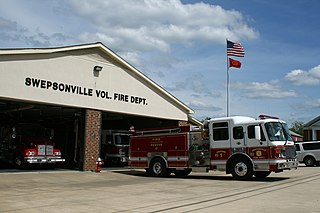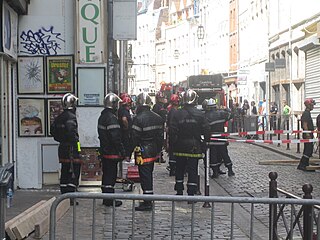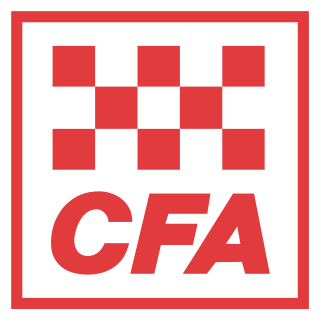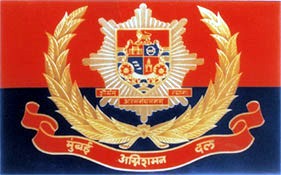
A paramedic is a healthcare professional who responds to emergency calls for medical help outside of a hospital. Paramedics mainly work as part of the emergency medical services (EMS), most often in ambulances. The scope of practice of a paramedic varies among countries, but generally includes autonomous decision making around the emergency care of patients.

Search and rescue (SAR) is the search for and provision of aid to people who are in distress or imminent danger. The general field of search and rescue includes many specialty sub-fields, typically determined by the type of terrain the search is conducted over. These include mountain rescue; ground search and rescue, including the use of search and rescue dogs ; urban search and rescue in cities; combat search and rescue on the battlefield and air-sea rescue over water.

A volunteer fire department (VFD) is a fire department of volunteers who perform fire suppression and other related emergency services for a local jurisdiction. Volunteer and retained (on-call) firefighters are expected to be on call to respond to emergency calls for long periods of time, and are summoned to the fire station when their services are needed. They are also expected to attend other non-emergency duties as well.
Fire police are fire brigade/company members who, based upon their jurisdictional authority, receive sworn police powers, special training, and support firefighting efforts at emergency incidents. In addition to securing firefighting equipment, incident and fire scenes, and the station itself, fire police perform traffic and crowd control. In some jurisdictions, fire police are exterior firefighters and may be called upon at fire scenes to perform any of the duties of an interior firefighter except those that require a self-contained breathing apparatus. On occasion, fire police also assist regular police: they perform road closures, traffic control, crowd control at public events, missing persons searches, parade details, salvage, security, and other miscellaneous tasks as requested.

The fire service in France is organised into local fire services which mostly cover the Departments of France, with a few exceptions. There are two types of fire service:

The Country Fire Authority (CFA) is a volunteer fire service responsible for fire suppression, rescues, and response to other accidents and hazards across most of the state Victoria, Australia. CFA comprises over 1,200 brigades organised in 21 districts, and shares responsibility for fire services with Fire Rescue Victoria (FRV), which employs full-time paid firefighters in major urban areas; and Forest Fire Management Victoria (FFMV), which manages fire prevention and suppression on Victoria's public lands. CFA operations and equipment are partly funded by the Victorian Government through its Fire Services Levy, and supplemented by individual brigades' fundraising for vehicles and equipment.

The South Australian Country Fire Service is a volunteer based fire service in the Australian state of South Australia. The CFS has responsibility as the Control Agency for firefighting, rescues and hazardous materials and inland waterways in the country regions of South Australia. Its official mission is "To protect life, property and the environment from fire and other emergencies whilst protecting and supporting our personnel and continuously improving."

The Department of Fire and Emergency Services (DFES) is a government department that is responsible for fire and emergency services in Western Australia. The department came into being in 2012 as a result of the Perth Hills Bush Fire review.DFES is responsible for the management, training and funding of career and volunteer Services including:
As firefighting has a rich history throughout the world, traditions in this profession vary widely from country to country.

The fire services in the United Kingdom operate under separate legislative and administrative arrangements in England and Wales, Northern Ireland, and Scotland.

Conscription in Finland is part of a general compulsion for national military service for all adult males defined in the section 127 of the Constitution of Finland.

The Estonian Rescue Board is a government agency under the Ministry of the Interior of Estonia. It is tasked with maintaining a secure environment in Estonia, anticipating threats and helping people in the event of an accident. Its mission is to prevent accidents, save lives, property, and the environment. The organization provides a large number of services, including emergency response, firefighting, oil pollution removal, explosive ordnance disposal, chemical and radiation hazard elimination, water rescue etc.

Lincolnshire Fire and Rescue (LFR) is the statutory fire and rescue service serving the non-metropolitan county of Lincolnshire in the East Midlands Region of England. This does not include North Lincolnshire and North East Lincolnshire, which are covered by Humberside Fire and Rescue Service.
Firefighting is the act of extinguishing destructive fires. A firefighter fights these fires with the intent to prevent destruction of life, property and the environment. Firefighting is a highly technical profession, which requires years of training and education in order to become proficient. A fire can rapidly spread and endanger many lives; however, with modern firefighting techniques, catastrophe can usually be avoided. To help prevent fires from starting, a firefighter's duties include public education and conducting fire inspections. Because firefighters are often the first responders to victims in critical conditions, firefighters often also provide basic life support as emergency medical technicians or advanced life support as licensed paramedics. Firefighters make up one of the major emergency services, along with the emergency medical service, the police, and many others.

The Mumbai Fire Brigade is the fire brigade serving the city of Mumbai, India. It is responsible for the provision of fire protection as well as responding to building collapses, drownings, gas leakage, oil spillage, road and rail accidents, bird and animal rescues, fallen trees and taking appropriate action during natural disasters.

The Swedish Civil Contingencies Agency is a Swedish administrative authority, organised under the Ministry of Justice. The agency is responsible for issues concerning civil protection, public safety, emergency management and civil defence. Responsibility refers to measures taken before, during and after an emergency or crisis. MSB work in close cooperation with the municipalities, the county councils, other authorities, organisations and the private sector to achieve increased safety and security at all levels of society. This is done through education, support, training exercises, regulation and supervision.
Many countries around the world have civil defense organizations dedicated to protecting civilians from military attacks and providing rescue services after widespread disasters. In most countries, civil defense is a government-managed and often volunteer-staffed organization.

The Tamil Nadu Fire and Rescue Services department is a service department of the Government of Tamil Nadu whose function is to fight fires and provide relief measures in times of calamities and disasters in Tamil Nadu.

The Hellenic Fire Service is the national agency of Greece for fire and rescue service. It is part of the Ministry for Citizen Protection.

China Fire and Rescue Force is the state emergency service force for firefighting and rescue in China, which is part of the civil service and administrated by the Ministry of Emergency Management (MEM).























